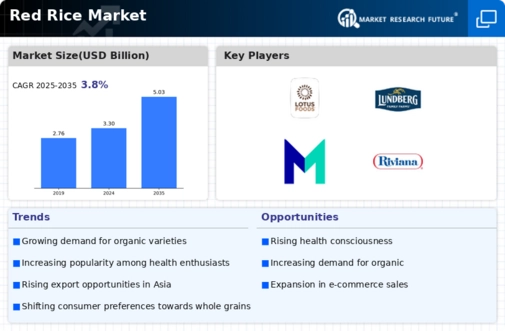Market Trends
Key Emerging Trends in the Red Rice Market
The market dynamics of the red rice industry reflect a confluence of factors influenced by consumer preferences, nutritional awareness, cultural significance, and agricultural practices. Red rice, often recognized for its distinctive color and nutritional benefits, has gained prominence as a healthier alternative to white rice. One of the key drivers shaping the market dynamics is the increasing demand for nutritious food options. Consumers are seeking whole grains that offer additional health benefits, and red rice, with its higher fiber content and antioxidants, has gained popularity as a nutritious choice, aligning with the global trend towards healthier eating habits.
The dynamics of the red rice market are also influenced by its cultural significance in various regions. In many Asian countries, red rice holds cultural importance and is often associated with traditional dishes and ceremonies. This cultural connection has contributed to the market growth as consumers appreciate red rice not only for its nutritional value but also for its cultural heritage. As globalization continues to promote diverse culinary experiences, red rice has transcended its cultural roots and found a place in the diets of health-conscious consumers worldwide.
The agricultural practices surrounding red rice cultivation play a pivotal role in market dynamics. Red rice varieties are typically grown using sustainable and organic farming methods, appealing to consumers who prioritize environmentally friendly and ethical food choices. The emphasis on sustainable agriculture contributes to the marketability of red rice as an eco-conscious option, attracting consumers who are mindful of the environmental impact of their food choices.
Furthermore, the nutritional profile of red rice positions it as a versatile ingredient in various culinary applications. The market dynamics are influenced by the use of red rice in a wide range of products, including rice-based dishes, salads, and even in the production of red rice flour for baked goods. The versatility of red rice in both traditional and innovative recipes contributes to its growing popularity and market demand.
Global economic factors, including trade dynamics and pricing, also impact the red rice market. Fluctuations in the cost of production, transportation, and import/export policies can influence the availability and pricing of red rice in different regions. The interconnectedness of the global economy necessitates market participants to navigate these economic factors to ensure a stable supply chain and meet consumer demand.
The dynamics of the red rice market are further shaped by nutritional awareness and the demand for gluten-free options. Red rice, being naturally gluten-free, caters to consumers with dietary restrictions or those seeking alternatives to traditional wheat-based products. The gluten-free trend, driven by health-conscious individuals and those with gluten sensitivity or celiac disease, has contributed to the market expansion of red rice-based products.
Consumer education and awareness campaigns about the health benefits of red rice play a role in shaping market dynamics. As consumers become more informed about the nutritional advantages of red rice, including its high fiber content, antioxidants, and potential cardiovascular benefits, the demand for red rice products is likely to continue growing. Market players often leverage these health-conscious trends in their marketing strategies to differentiate red rice from other rice varieties.








Leave a Comment